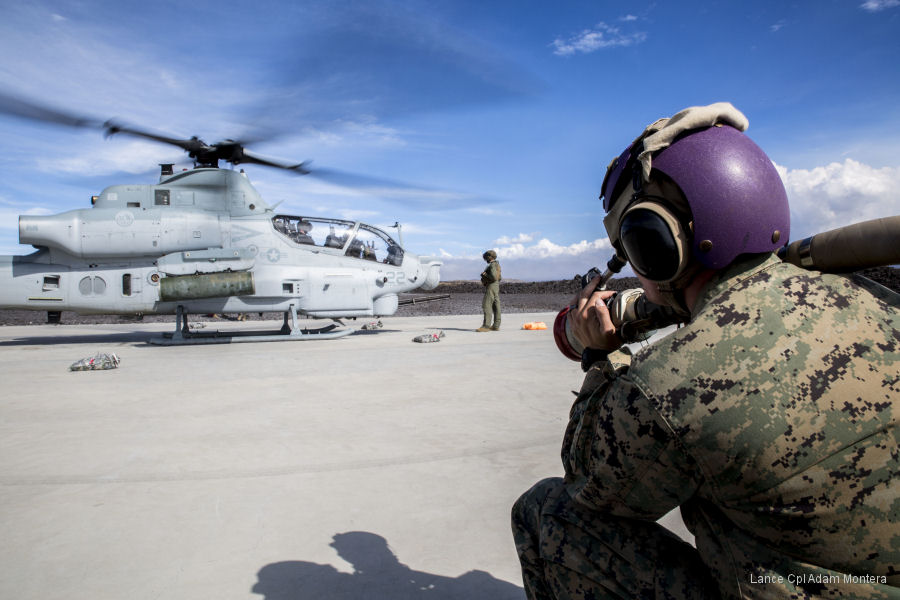
US Marine Corps, July 18, 2018 - POHAKULOA TRAINING AREA, Hawaii by Lance Cpl Adam Montera - U.S. service members performed a field test for the Expeditionary Mobile Fuel Additization Capability system July 18 here, during the Rim of the Pacific, or RIMPAC, exercise.
The Expeditionary Mobile Fuel Additization Capability, or EMFAC, is designed to convert commercially available jet fuel into military specification Jet Propellant 8, or better know in the military as JP-8, a necessity in a field environment where military specification fuel isn’t readily available.
With more than 25,000 troops from 26 nations present in Hawaii, flight operations are needed around the clock for the biennial RIMPAC, which serves as a good stage to test the EMFAC in the field.
The process begins with fuel that is believed to not have any additives, known as “neat fuel,” and a test is performed to confirm that assumption.
“Once we have tested for [neat fuel], we can calibrate the EMFAC to how much additive we want to put in that fuel, so it is on grade and ready to be pushed into military aircraft and ground vehicles,” said U.S. Marine Corps Lance Cpl. David Keeton, a bulk fuel specialist with Marine Wing Support Detachment 24 (MWSD-24), Marine Aircraft Wing 24, based out of Marine Corps Air Station Kaneohe Bay.
This technology has been available for some time in the Army, Navy and Air Force; the Marine Corps is now looking to start using this technology. The goal for the small and highly mobile system will allow for greater efficiency and expedience when refueling aircraft in the field.
During the test, a transport truck filled with neat fuel was brought to a Forward Arming and Refueling Point at PTA, where it was converted to JP8 military specified fuel. After a successful conversion, the fuel was used in U.S. Marine UH-1Y Huey and AH-1Z Venom helicopters participating in RIMPAC.
The test was a success and showed the usefulness of the EMFAC and helped familiarize service members with how to properly use the system in a field environment, according to U.S. Marine Cpl. Travis Kopelson, a bulk fuel specialist with MWSD-24.
“I believe this piece of equipment definitely helps us become more self-sufficient,” Kopelson said. He went on to discuss scenarios in which converting commercial fuel into JP-8 could be a necessity.
“We could easily go to the nearest airport or air field … and we can turn [their fuel] into our own military-grade fuel,” Kopelson added.
RIMPAC continues with the more than 200 aircraft from several nations operating around the Hawaiian Islands through Aug. 2. RIMPAC provides high-value training for task-organized, highly capable Marine Air-Ground Task Force and enhances the critical crisis response capability of U.S. Marines in the Pacific.
The Expeditionary Mobile Fuel Additization Capability, or EMFAC, is designed to convert commercially available jet fuel into military specification Jet Propellant 8, or better know in the military as JP-8, a necessity in a field environment where military specification fuel isn’t readily available.
With more than 25,000 troops from 26 nations present in Hawaii, flight operations are needed around the clock for the biennial RIMPAC, which serves as a good stage to test the EMFAC in the field.
The process begins with fuel that is believed to not have any additives, known as “neat fuel,” and a test is performed to confirm that assumption.
“Once we have tested for [neat fuel], we can calibrate the EMFAC to how much additive we want to put in that fuel, so it is on grade and ready to be pushed into military aircraft and ground vehicles,” said U.S. Marine Corps Lance Cpl. David Keeton, a bulk fuel specialist with Marine Wing Support Detachment 24 (MWSD-24), Marine Aircraft Wing 24, based out of Marine Corps Air Station Kaneohe Bay.
This technology has been available for some time in the Army, Navy and Air Force; the Marine Corps is now looking to start using this technology. The goal for the small and highly mobile system will allow for greater efficiency and expedience when refueling aircraft in the field.
During the test, a transport truck filled with neat fuel was brought to a Forward Arming and Refueling Point at PTA, where it was converted to JP8 military specified fuel. After a successful conversion, the fuel was used in U.S. Marine UH-1Y Huey and AH-1Z Venom helicopters participating in RIMPAC.
The test was a success and showed the usefulness of the EMFAC and helped familiarize service members with how to properly use the system in a field environment, according to U.S. Marine Cpl. Travis Kopelson, a bulk fuel specialist with MWSD-24.
“I believe this piece of equipment definitely helps us become more self-sufficient,” Kopelson said. He went on to discuss scenarios in which converting commercial fuel into JP-8 could be a necessity.
“We could easily go to the nearest airport or air field … and we can turn [their fuel] into our own military-grade fuel,” Kopelson added.
RIMPAC continues with the more than 200 aircraft from several nations operating around the Hawaiian Islands through Aug. 2. RIMPAC provides high-value training for task-organized, highly capable Marine Air-Ground Task Force and enhances the critical crisis response capability of U.S. Marines in the Pacific.
See also |
HMLA-367
UH-1Y Venom in
Bell AH-1Z Viper




